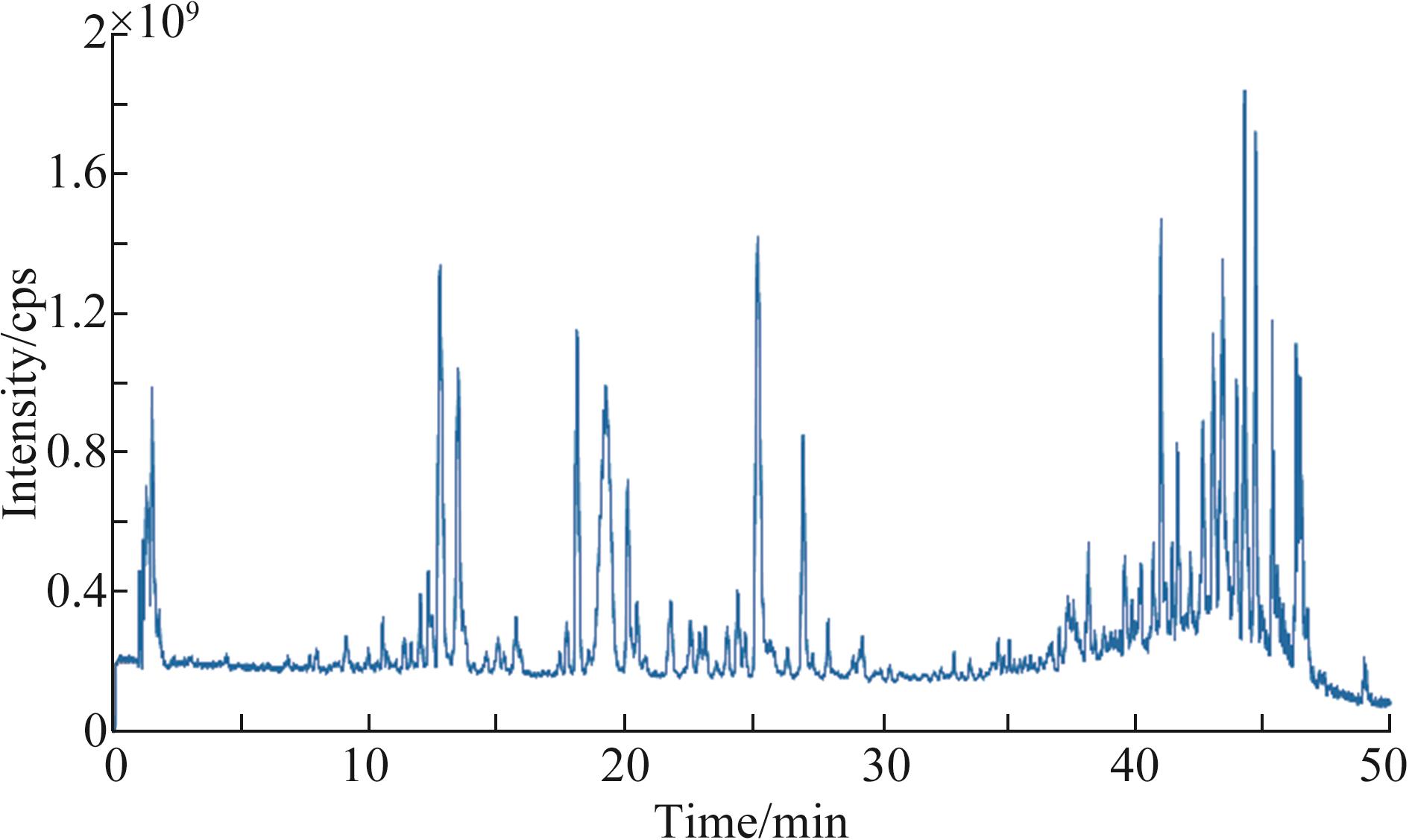
应用化学 ›› 2022, Vol. 39 ›› Issue (5): 819-827.DOI: 10.19894/j.issn.1000-0518.210160
基于超高效液相色谱联用高分辨质谱自动解析方法的金银花不同加工方式分析
李淑芳1( ), 郝学飞1, 王红旗1, 郭晓萌2, 冯书惠1, 尹海燕1, 刘冬梅1, 于永杰2
), 郝学飞1, 王红旗1, 郭晓萌2, 冯书惠1, 尹海燕1, 刘冬梅1, 于永杰2
- 1.河南省农业科学院农业质量标准与检测技术研究所,郑州 450002
2.宁夏医科大学药学院,银川 750004
-
收稿日期:2021-04-02接受日期:2021-07-07出版日期:2022-05-01发布日期:2022-05-24 -
通讯作者:李淑芳 -
基金资助:国家自然科学基金(21868028);河南省农业科学院优秀青年科技基金(2020YQ16);河南省农业科学院自主创新专项基金(2022ZC54);宁夏回族自治区重点研发计划(2020BEG03039)
Automatic Data Analysis Strategy Coupled with Q Exactive High Resolution Mass Spectrometry for Studying Different Industrial Process of Lonicerae Japonicae Flos
Shu-Fang LI1( ), Xue-Fei HAO1, Hong-Qi WANG1, Xiao-Meng GUO2, Shu-Hui FENG1, Hai-Yan YIN1, Dong-Mei LIU1, Yong-Jie YU2
), Xue-Fei HAO1, Hong-Qi WANG1, Xiao-Meng GUO2, Shu-Hui FENG1, Hai-Yan YIN1, Dong-Mei LIU1, Yong-Jie YU2
- 1.Institute of Quality Standard and Testing Technology for Agro-products,Henan Academy of Agricultural Science,Zhengzhou 450002,China
2.College of Pharmacy,Ningxia Medical University,Yinchuan 750004,China
-
Received:2021-04-02Accepted:2021-07-07Published:2022-05-01Online:2022-05-24 -
Contact:Shu-Fang LI -
About author:lishufang@hnagri.org.cn
-
Supported by:the National Natural Science Foundation of China(21868028);the Science?Technology Foundation for Outstanding Young Scientists of Henan Academy of Agricultural Sciences(2020YQ16);the Special Foundation for Zndependent Innovation of Henan Academy of Aqricultural Sciences(2022ZC54);the Key Research and Development Program of Ningxia(2020BEG03039)
摘要:
金银花干燥加工方式直接影响其药用价值及经济效益。 采用基于超高效液相色谱联用静电场轨道阱高分辨质谱的非靶向代谢组学技术结合化学计量学自动化数据分析策略,分析了不同加工方式对金银花中化学成分的影响。金银花样品经甲醇-水(8∶2,体积比)溶液超声提取30 min,两次离心后取上清液,以Waters Acquity UPLC HSS T3色谱柱(2.1×100 mm, 1.8 μm)分离,乙腈-水溶液(均含有体积分数0.1%的甲酸)进行梯度洗脱。高分辨质谱选择正离子扫描模式(ESI+)并采用FULL MS/DD-MS2(TOP4)模式完成数据采集。在自动化解析方法软件平台对仪器采集的原始信号直接解析,鉴定出绿原酸、芦丁和异槲皮苜等16种差异性化合物。在化学成分解析的基础上,利用层次聚类分析和主成分分析等方法评价了晒干、阴干、电热烘干、烘房烘干、热泵烘干和真空冷冻干燥这6种加工方式获得的金银花样品品质差异。真空冷冻干燥、烘房烘干和热泵干燥等加工方式能够获得外观特征优质的金银花。在真空冷冻干燥方式下,金银花样品中的抗氧化功能性成分能够得到更好的保存。
中图分类号:
引用本文
李淑芳, 郝学飞, 王红旗, 郭晓萌, 冯书惠, 尹海燕, 刘冬梅, 于永杰. 基于超高效液相色谱联用高分辨质谱自动解析方法的金银花不同加工方式分析[J]. 应用化学, 2022, 39(5): 819-827.
Shu-Fang LI, Xue-Fei HAO, Hong-Qi WANG, Xiao-Meng GUO, Shu-Hui FENG, Hai-Yan YIN, Dong-Mei LIU, Yong-Jie YU. Automatic Data Analysis Strategy Coupled with Q Exactive High Resolution Mass Spectrometry for Studying Different Industrial Process of Lonicerae Japonicae Flos[J]. Chinese Journal of Applied Chemistry, 2022, 39(5): 819-827.
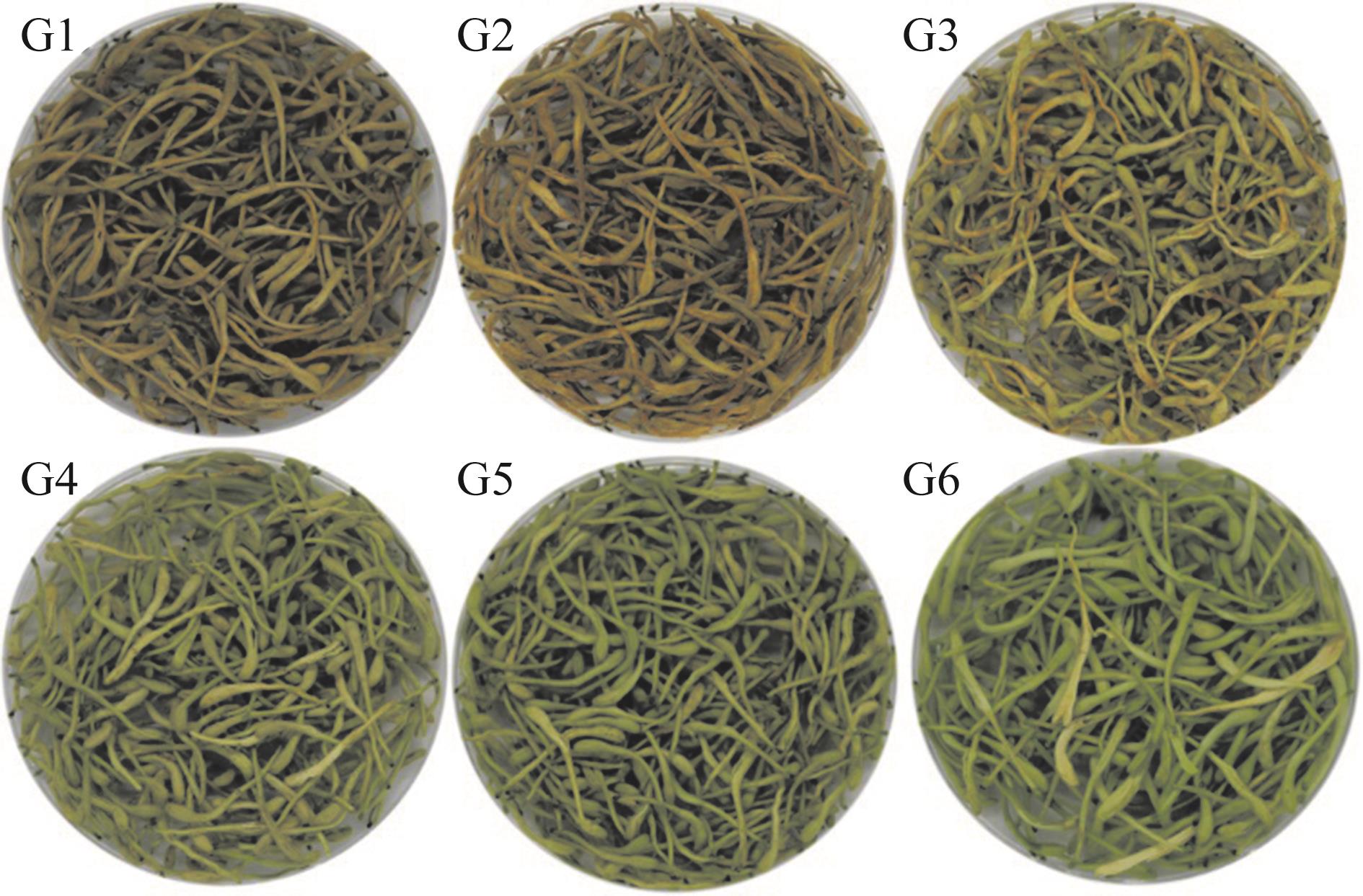
图 1 不同加工方法金银花外观性状(G1)晒干;(G2)阴干;(G3)电热烘干;(G4)烘房烘干;(G5)热泵烘干;(G6)真空冷冻干燥
Fig.1 Appearance of Lonicerae Japonicae Flos from different processing methods(G1) Sun drying; (G2) Shade drying; (G3) Oven drying; (G4) Hot chamber drying; (G5) Hot pump drying; (G6) Vacuum freeze drying
时间 Time/min | 流动相A% Mobile phase A% | 流动相B% Mobile phase B% | 时间 Time/min | 流动相A% Mobile phase A% | 流动相B% Mobile phase B% |
|---|---|---|---|---|---|
| 0.0 | 0 | 100 | 28.0 | 30 | 70 |
| 2.0 | 1 | 99 | 30.0 | 40 | 60 |
| 5.0 | 5 | 95 | 38.0 | 88 | 22 |
| 8.0 | 10 | 90 | 40.0 | 90 | 10 |
| 16.0 | 15 | 85 | 43.0 | 100 | 0 |
| 23.0 | 20 | 80 | 50.0 | 100 | 0 |
表1 UHPLC?HRMS色谱洗脱梯度
Table 1 The gradient elution procedure of UHPLC?HRMS
时间 Time/min | 流动相A% Mobile phase A% | 流动相B% Mobile phase B% | 时间 Time/min | 流动相A% Mobile phase A% | 流动相B% Mobile phase B% |
|---|---|---|---|---|---|
| 0.0 | 0 | 100 | 28.0 | 30 | 70 |
| 2.0 | 1 | 99 | 30.0 | 40 | 60 |
| 5.0 | 5 | 95 | 38.0 | 88 | 22 |
| 8.0 | 10 | 90 | 40.0 | 90 | 10 |
| 16.0 | 15 | 85 | 43.0 | 100 | 0 |
| 23.0 | 20 | 80 | 50.0 | 100 | 0 |
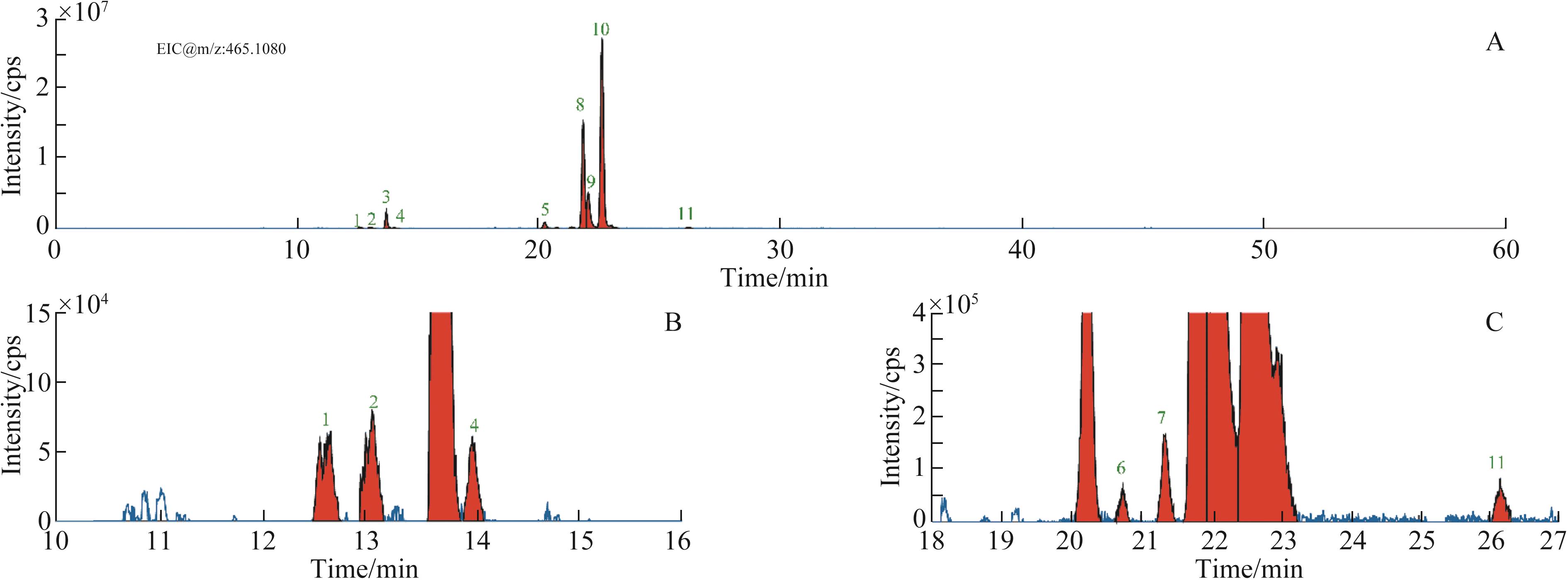
图4 AntDAS提取EIC中色谱峰示例。(A)EIC中色谱峰提取结果,(B)和(C)为局部放大图
Fig.4 Illustration of the EIC peak extraction in the AntDAS. (A) The EIC peak extraction results, (B) and (C) are margined parts of (A)
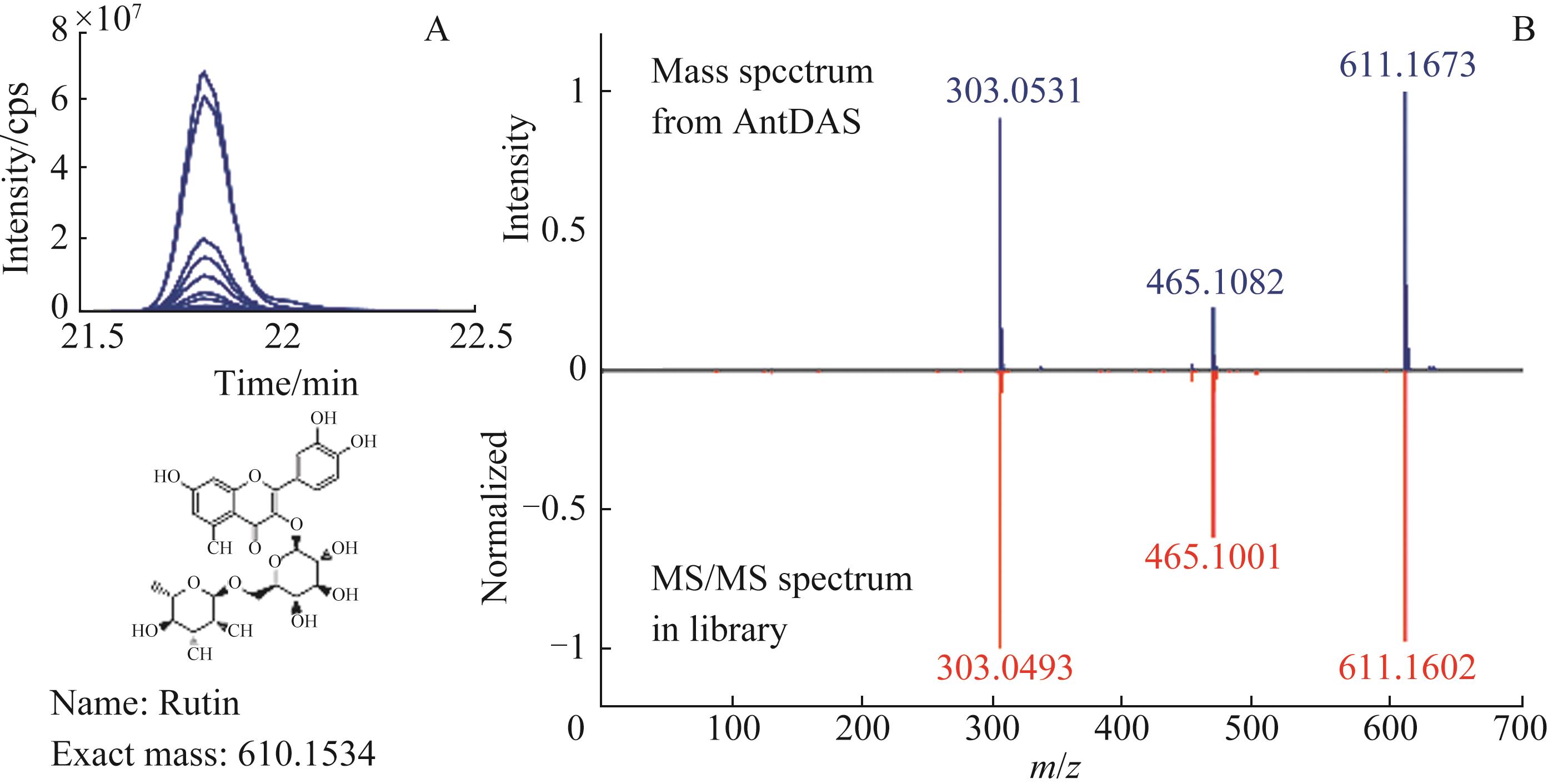
图5 利用AntDAS进行代谢物鉴别过程示例(A)筛选出化合物的色谱图及其结构信息; (B)筛选出的化合物质谱谱图与标准谱库进行匹配
Fig.5 Illustration of the compound identification process by AntDAS(A) EIC profiles of the ions in (B). (B) Compound identification result for the constructed mass spectrum
序号 No. | 保留时间 RT/min | 准分子离子峰 [M+H]+(m/z) | 化合物 Compound | 分子式 Chemical formula | CAS编号 CAS No. |
|---|---|---|---|---|---|
| 1 | 1.52 | 348.0742 | Adenosine 5'?monophosphate(腺苷酸) | C10H14N5O7P | 61?19?8 |
| 2 | 7.52 | 268.1071 | Adenosine(腺苷) | C10H13N5O4 | 58?61?7 |
| 3 | 7.73 | 284.1022 | Guanosine(鸟苷) | C10H13N5O5 | 118?00?3 |
| 4 | 9.99 | 382.1754 | Cis?Zeatin?9?glucoside(顺式?玉米素?9?葡糖苷) | C16H23N5O6 | 38165?56?9 |
| 5 | 10.70 | 205.0995 | Tryptophan(色氨酸) | C11H12N2O2 | 73?22?3 |
| 6 | 12.38 | 197.0830 | Xanthoxylin(4,6?二甲基?2?羟基苯乙酮) | C10H12O4 | 90?24?4 |
| 7 | 12.85 | 355.1057 | Chlorogenic acid(绿原酸) | C16H18O9 | 327?97?9 |
| 8 | 15.82 | 359.1375 | Sweroside(獐牙菜苷) | C16H22O9 | 14215?86?2 |
| 9 | 21.78 | 451.1285 | Okanin?4'?O?glucoside(马里苷) | C21H22O11 | 535?96?6 |
| 10 | 21.83 | 611.1674 | Rutin(芦丁) | C27H30O16 | 153?18?4 |
| 11 | 22.60 | 465.1078 | Isoquercetin(异槲皮苜) | C21H20O12 | 482?35?9 |
| 12 | 24.75 | 595.1722 | Nicotiflorin(烟花苷) | C27H30O15 | 17650?84?9 |
| 13 | 25.59 | 449.1128 | Cyanidin?3?O?glucoside(花青素?3?O?葡萄糖苷) | C21H21O11 | 47705?70?4 |
| 14 | 25.62 | 625.1827 | Isorhamnetin?3?O?rutinoside(水仙苷) | C28H32O16 | 53584?69?3 |
| 15 | 26.43 | 479.1241 | Isorhamnetin?3?O?glucoside(异鼠李素?3?O?葡萄糖苷) | C22H22O12 | 5041?82?7 |
| 16 | 27.27 | 463.1291 | Peonidin?3?O?glucoside(氯化葡萄糖苷芍药素) | C22H23O11 | 6906?39?4 |
表2 AntDAS鉴定出的16种差异性代谢物
Table 2 16 different metabolites identified by AntDAS
序号 No. | 保留时间 RT/min | 准分子离子峰 [M+H]+(m/z) | 化合物 Compound | 分子式 Chemical formula | CAS编号 CAS No. |
|---|---|---|---|---|---|
| 1 | 1.52 | 348.0742 | Adenosine 5'?monophosphate(腺苷酸) | C10H14N5O7P | 61?19?8 |
| 2 | 7.52 | 268.1071 | Adenosine(腺苷) | C10H13N5O4 | 58?61?7 |
| 3 | 7.73 | 284.1022 | Guanosine(鸟苷) | C10H13N5O5 | 118?00?3 |
| 4 | 9.99 | 382.1754 | Cis?Zeatin?9?glucoside(顺式?玉米素?9?葡糖苷) | C16H23N5O6 | 38165?56?9 |
| 5 | 10.70 | 205.0995 | Tryptophan(色氨酸) | C11H12N2O2 | 73?22?3 |
| 6 | 12.38 | 197.0830 | Xanthoxylin(4,6?二甲基?2?羟基苯乙酮) | C10H12O4 | 90?24?4 |
| 7 | 12.85 | 355.1057 | Chlorogenic acid(绿原酸) | C16H18O9 | 327?97?9 |
| 8 | 15.82 | 359.1375 | Sweroside(獐牙菜苷) | C16H22O9 | 14215?86?2 |
| 9 | 21.78 | 451.1285 | Okanin?4'?O?glucoside(马里苷) | C21H22O11 | 535?96?6 |
| 10 | 21.83 | 611.1674 | Rutin(芦丁) | C27H30O16 | 153?18?4 |
| 11 | 22.60 | 465.1078 | Isoquercetin(异槲皮苜) | C21H20O12 | 482?35?9 |
| 12 | 24.75 | 595.1722 | Nicotiflorin(烟花苷) | C27H30O15 | 17650?84?9 |
| 13 | 25.59 | 449.1128 | Cyanidin?3?O?glucoside(花青素?3?O?葡萄糖苷) | C21H21O11 | 47705?70?4 |
| 14 | 25.62 | 625.1827 | Isorhamnetin?3?O?rutinoside(水仙苷) | C28H32O16 | 53584?69?3 |
| 15 | 26.43 | 479.1241 | Isorhamnetin?3?O?glucoside(异鼠李素?3?O?葡萄糖苷) | C22H22O12 | 5041?82?7 |
| 16 | 27.27 | 463.1291 | Peonidin?3?O?glucoside(氯化葡萄糖苷芍药素) | C22H23O11 | 6906?39?4 |
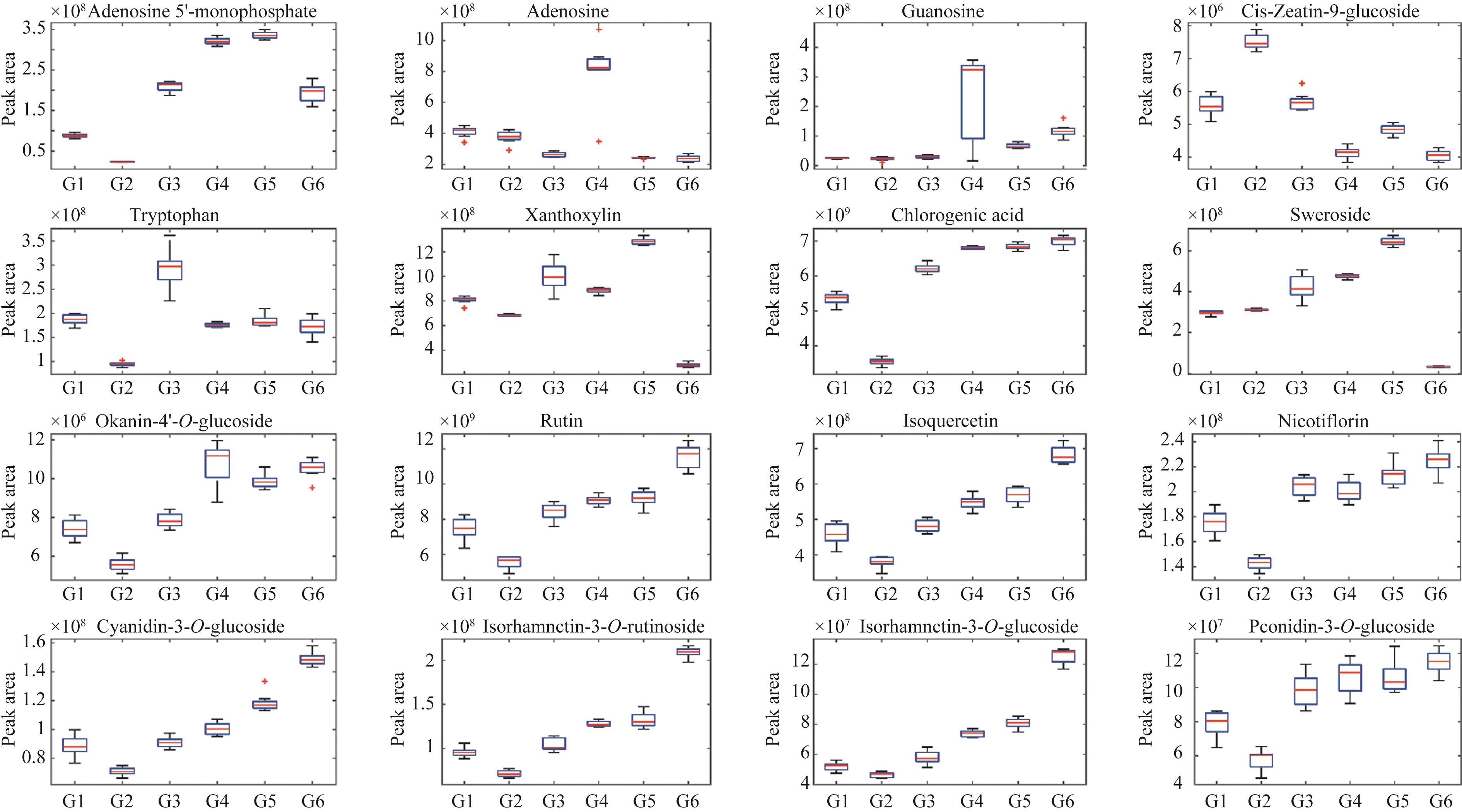
图6 16种差异性成分在不同加工方式中的峰面积分布G1:晒干;G2:阴干;G3:电热烘干;G4:烘房烘干;G5:热泵烘干;G6:真空冷冻干燥
Fig.6 Peak areas of 16 different metabolites in various processing methodsG1: Sun drying; G2: Shade drying; G3: Oven drying; G4: Hot chamber drying; G5: Heat pump drying; G6: Vacuum freeze drying
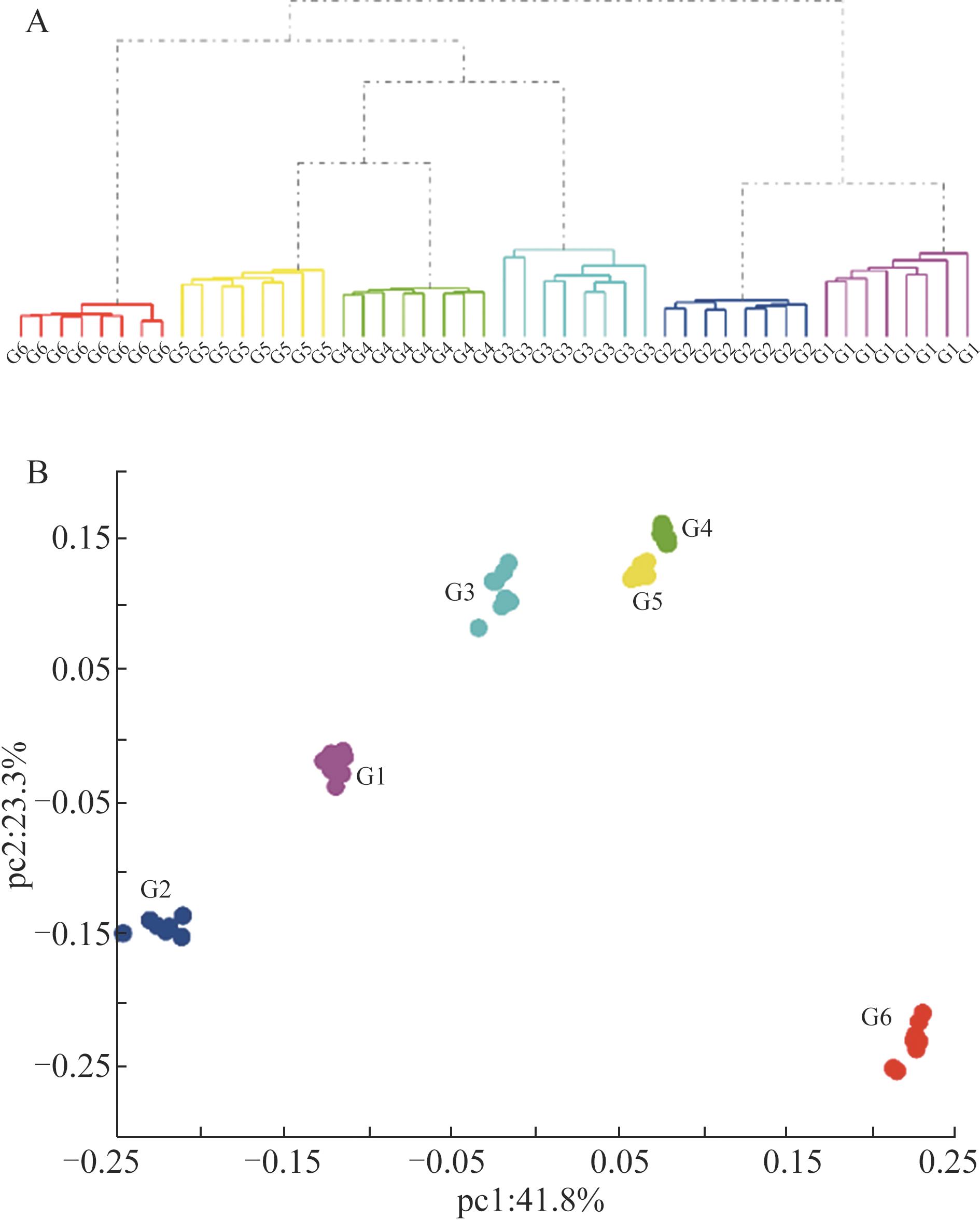
图7 不同加工方式的HCA和PCA分析结果(A)HCA聚类结果; (B)PCA得分图。G1:晒干;G2:阴干;G3:电热烘干;G:烘房烘干;G5:热泵烘干;G6:真空冷冻干燥
Fig.7 Analysis of HCA and PCA from different processing methods(A) and (B) are sample clustering results by HCA and PCA, respectively. G1: Sun drying; G2: Shade drying; G3: Oven drying; G4: Hot chamber drying; G5: Hot pump drying; G6: Vacuum freeze drying
| 1 | 国家药典委员会. 中华人民共和国药典: 一部[M]. 北京: 中国医药科技出版社, 2015: 221. |
| Chinese Pharmacopoeia Commission. China Pharmacopeia: volume I[M]. Beijing: Chinese Medical Science and Technology Press, 2015: 221. | |
| 2 | 李哲, 赵振华, 玄静, 等. 金银花干燥加工研究进展[J]. 辽宁中医药大学学报, 2019, 21(8): 156-159. |
| LI Z, ZHAO Z H, XUAN J, et al. Research progress of primary processing of Lonicerae Japonicae Flos[J]. J Liaoning Univ TCM, 2019, 21(8): 156-159. | |
| 3 | 罗磊, 康新艳, 朱文学, 等. 热泵远红外联合干燥金银花的工艺优化及品质控制[J]. 食品科学, 2016, 37(18): 6-12. |
| LUO L, KANG X Y, ZHU W X, et al. Optimization of far-infrared assisted heat pump drying parameters for quality control of dried honeysuckle[J]. Food Sci, 2016, 37(18): 6-12. | |
| 4 | 彭菊艳, 龚月桦, 王俊儒, 等. 不同干燥技术对金银花药用品质的影响[J]. 西北植物学报, 2006, 26(10): 2044-2050. |
| PENG J Y, GONG Y H, WANG J R, et al. Effects of different dring methods on officinal qualities of Flos lonicerace[J]. Acta Bot Boreal-Occident Sin, 2006, 26(10): 2044-2050. | |
| 5 | 王亚丹, 杨建波, 戴忠, 等. 中药金银花的研究进展[J].药物分析杂志, 2014, 34(11): 1928-1935. |
| WANG Y D, YANG J B, DAI Z, et al. Research progress on Lonicerae Japonicae Flos[J]. Chin J Pharm Anal, 2014, 34(11): 1928-1935. | |
| 6 | 王萌, 王建成, 刘钧宁, 等. HPLC法测定不同加工方法金银花中绿原酸和木犀草苷的含量[J]. 药学研究, 2014, 33(5): 261-263. |
| WANG M, WANG J C, LIU J N, et al. Determination of chlorogenic acid and galuteolin with different processing methods in Flos lonicerae by HPLC[J]. J Pharm Res, 2014, 33(5): 261-263. | |
| 7 | 刘涛, 王鸿, 李青苗, 等. 不同采收期金银花的产地加工方法考察[J]. 中国实验方剂学杂志, 2016, 22(10): 28-31. |
| LIU T, WANG H, LI Q M, et al. Origin processing method for Lonicera Japonica Flos from different harvest time[J]. Chinese J ETMF, 2016, 22(10): 28-31. | |
| 8 | 邹容, 游玉明, 陈泽雄, 等. 干燥方式对金银花多酚组分及其抗氧化活性的影响[J].食品科学, 2016, 37(5): 78-83. |
| ZOU R, YOU Y M, CHEN Z X, et al. Effects of drying methods on polyphenol compounds and antioxidant activities of Lonicera japonica flower[J]. Food Sci, 2016, 37(5): 78-83. | |
| 9 | 吴昱铮, 王广基, 郝海平. 中药代谢组学研究进展[J].中国药科大学学报, 2014, 45(2): 129-135. |
| WU Y Z, WANG G J, HAO H P. Advances of metabolomic research of traditional Chinese medicine[J]. J China Pharm Univ, 2014, 45(2): 129-135. | |
| 10 | 李丽丽, 李月, 卢恒, 等. 基于液相色谱-质谱法的不同花期金银花代谢组学分析[J]. 分析测试学报, 2020, 39(2): 1501-1507. |
| LI L L, LI Y, LU H, et al. Metabolomics analysis of Lonicera japonica in different flowering stages base on liquid chromatography-mass spectrometry[J]. J Instrum Anal, 2020, 39(2): 1501-1507. | |
| 11 | 宋亚玲, 倪付勇, 赵祎武, 等. 金银花化学成分研究进展[J].中草药, 2014, 45(24): 3656-3664. |
| SONG Y L, NI F Y, ZHAO Y W, et al. Research progress on chemical constituents from Lonicerae Flos[J]. Chin Tradit Herb Drugs, 2014, 45(24): 3656-3664. | |
| 12 | 李泮霖, 李楚源, 刘孟华, 等. 基于UFLC-Triple-Q-TOF-MS/MS技术的金银花、山银花化学成分比较[J]. 中南药学, 2016, 14(4): 363-369. |
| LI P L, LI C Y, LIU M H, et al. Systematic analysis of chemical constitue of Lonicerae Japonicae Flos and Lonicerae Flos by UFLC-Triple-Q-TOF-MS/MS[J]. Central South Pharm, 2016, 14(4): 363-369. | |
| 13 | LI Y K, LI W, FU C M, et al. Lonicerae japonicae flos and Lonicerae flos: a systematic review of ethnopharmacology, phytochemistry and pharmacology[J]. Phytochem Rev, 2020, 19: 1-61. |
| 14 | 徐天润, 刘心昱, 许国旺. 基于液相色谱-质谱联用技术的代谢组学分析方法研究进展[J]. 分析测试学报, 2020, 39(1): 10-18. |
| XU T R, LIU X Y, XU G W. Advances of analytical methods for liquid chromatography-mass spectrometry-based metabolomics[J]. J Instrum Anal, 2020, 39(1): 10-18. | |
| 15 | FU H Y, GUO X M, ZHANG Y M, et al. AntDAS: automatic data analysis strategy for UPLC-QTOF-based nontargeted metabolic profiling analysis[J]. Anal Chem, 2017, 89: 11083-11090. |
| [1] | 段骁, 曹锋, 周扬, 张斌, 董蔚雯, 魏伶俐, 李佳, 刘建国. 高精度无损质子交换膜燃料电池膜电极Pt载量与分布测试方法[J]. 应用化学, 2023, 40(6): 845-852. |
| [2] | 肖娟, 石志锋, 刘佳, 李冰, 徐昕荣. 样品质量控制对X射线衍射测量结果的影响[J]. 应用化学, 2023, 40(5): 720-729. |
| [3] | 刘明言, 石秀顶, 李天国, 王静. 电化学分析方法检测重金属离子研究进展[J]. 应用化学, 2023, 40(4): 463-475. |
| [4] | 于红丽, 周思仪, 洪琛, 罗稳. 基于黄酮骨架的“关-开”型荧光探针用于检测活细胞内丁酰胆碱酯酶[J]. 应用化学, 2023, 40(4): 500-508. |
| [5] | 周锐, 张自品. 生物样品中小檗碱的电化学分析新方法[J]. 应用化学, 2023, 40(4): 518-526. |
| [6] | 刘振邦, 张硕, 包宇, 马英明, 梁蔚淇, 王伟, 何颖, 牛利. 深度学习在化学信息学中的应用研究进展[J]. 应用化学, 2023, 40(3): 360-373. |
| [7] | 吴蕾, 李凌云, 彭永臻. 基于全反射X射线荧光光谱测定污水痕量重金属元素[J]. 应用化学, 2023, 40(3): 404-412. |
| [8] | 冷泽山, 郭洪梅, 蔡函青, 张剑. 高效液相色谱-电雾式检测器法同时检测食品中8种人工甜味剂的应用[J]. 应用化学, 2023, 40(3): 436-440. |
| [9] | 姜士鹏, 周禹希, 孟沛然, 谢炎轩, 宋祉怡, 赵洹影, 孙越. 基于无金属可见光诱导原子转移自由基聚合方法制备人血清白蛋白超微印迹传感器及其性能[J]. 应用化学, 2023, 40(2): 299-308. |
| [10] | 王瑞, 孟祥茹, 李琼, 王恩鹏, 黄鑫, 陈长宝. 人参属中药腐解化感作用研究进展[J]. 应用化学, 2023, 40(1): 1-8. |
| [11] | 李玉凰, 卢泽毅, 袁红梅, 王刚, 张成江. 酰腙键聚合物凝胶的制备及其在硝基呋喃类药物分析中的应用[J]. 应用化学, 2023, 40(1): 100-108. |
| [12] | 刘静婉, 李琼, 张涛, 王恩鹏, 王欢, 陈雪, 陈长宝. 从改良土壤角度探索人参连作障碍解决方法的研究进展[J]. 应用化学, 2022, 39(12): 1818-1832. |
| [13] | 秦丽, 尤晓亭, 唐录华, 李建文, 张寅, 高文惠, 韩俊华. 基于纳米材料修饰的碱性嫩黄O印迹传感器的制备及其应用[J]. 应用化学, 2022, 39(12): 1880-1890. |
| [14] | 刘静婉, 李琼, 王恩鹏, 张涛, 王欢, 张哲, 陈雪, 陈长宝. 人参栽培研究进展[J]. 应用化学, 2022, 39(11): 1641-1651. |
| [15] | 袁琳, 吴彦, 楚刘喜, 王为, 朱敏惠, 张贺, 杨瑾, 邓慧华. 头发中甲状腺激素和类固醇激素的高效液相色谱串联质谱检测[J]. 应用化学, 2022, 39(11): 1703-1715. |
| 阅读次数 | ||||||
|
全文 |
|
|||||
|
摘要 |
|
|||||
